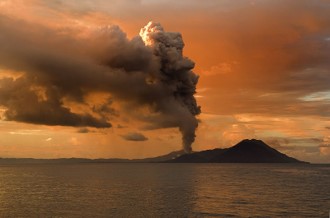1816 The Year Without a Summer
How do natural cataclysmic processes of the Earth influence art, history, civilization, and more? The 1815 eruption of Mount Tambora in Indonesia affected the entire world, erupting volcanic ash into the atmosphere and causing the “Year Without a Summer”. As the world’s largest and deadliest volcanic eruption in recorded history this left a major impact on culture worldwide including the inspiration for Mary Shelley’s Frankenstein. Learn how climatic abnormalities led to massive global agricultural failures and major demographic shifts with a lasting legacy today. Leave with a better understanding of volcanoes and how they can affect the natural world.

As a research scientist at the US Geological Survey, I found this topic fascinating as it represents the interconnectivity of Earth science. This shows how the Earth operates as a global system where a geological event on a remote island on the other side of the world can have a lasting effect today. As a geologist and geographer who studies agriculture and water use on a global scale using satellite remote sensing, I found this topic very appropriate for this year. With the theme of Harvesting Knowledge ,we will learn how a cataclysmic volcanic eruption led to mass famine and crop failures which sparked major changes in society. Learn about how this volcanic induced food insecurity in turn led to mass migrations and cultural shifts that influenced literature, science, and society across the globe. Many inventions can be linked to the 1816 Year without a Summer from Dracula to the Bicycle. Furthermore, connections can be drawn to 19th century developments in food science with the introduction of mineral fertilizers and baby formula.

Geology is often a study of pre-historic processes and materials gathered from the ancient rock record. We will begin to understand the great quote by Philosopher Will Durant that “Civilization exists subject to geological consent, subject to change without notice”. For a geological event that happened not that long ago it is amazing to look at the perspective that Earth Science is not just confined to the museums and textbooks, that it is relevant in everyday life. Especially in a place such as Flagstaff where we are surrounded by volcanic mountains under a volcanic field still considered “active” with an eruption occurring only a millennium ago we can appreciate that we are living on an active planet. This can help to gain more insight into why a better understanding of a broad range science is important






 Board member, Adam Marsh, and lead paleontologist at Petrified National Forest, works with a team of scientists to uncover an approximately 300 million-year-old fossil skeleton discovered at Canyonlands National Park in Utah (June 2024)
Board member, Adam Marsh, and lead paleontologist at Petrified National Forest, works with a team of scientists to uncover an approximately 300 million-year-old fossil skeleton discovered at Canyonlands National Park in Utah (June 2024)